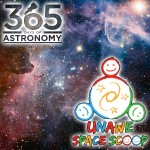Podcaster: Richard Drumm
 Title: Space Scoop: The Universal Laws of Science
Title: Space Scoop: The Universal Laws of Science
Organization: 365 Days Of Astronomy
Link : astrosphere.org ; http://unawe.org/kids/unawe1265/
Description: Space scoop, news for children.
Bio: Richard Drumm is President of the Charlottesville Astronomical Society and President of 3D – Drumm Digital Design, a video production company with clients such as Kodak, Xerox and GlaxoSmithKline Pharmaceuticals. He was an observer with the UVa Parallax Program at McCormick Observatory in 1981 & 1982. He has found that his greatest passion in life is public outreach astronomy and he pursues it at every opportunity.
Today’s sponsor: This episode of “365 Days of Astronomy” is sponsored by — no one. We still need sponsors for many days in 2015, so please consider sponsoring a day or two. Just click on the “Donate” button on the lower left side of this webpage, or contact us at signup@365daysofastronomy.org.
Transcript:
This is 365 Days of Astronomy. Today we bring you a new episode in our Space Scoop series. This show is produced in collaboration with Universe Awareness, a program that strives to inspire every child with our wonderful cosmos.
Today’s story is:
The Universal Laws of Science
Science, especially Physics, is like a Universal language, as everything in the Universe works in exactly the same way. The science that we experience on Earth is the same as the science that makes stars shine and planets travel around the Sun!
Take sunsets, for example. On Earth, we often see beautiful displays of red & orange in the sky when the sun sets. This is because when the Sun is low in the sky its light bounces off more dust in the atmosphere and is scattered away in different random directions.
Light is made up of all of the colors of the rainbow, but the colors scatter differently. Dust in the air scatters blue light more than red light. This means that the blue light is scattered away like some atmospheric Pachinko game. The longer wavelength red light penetrates the dust easily, travels through the atmosphere and makes a beautiful red sky at sunset.
Well, the same thing happens in space. Dusty regions of space absorb and scatter blue light more than red. In some very dusty parts of the Universe, such as star-forming clouds, this effect is so strong that all the light can be blocked. All that we can see by eye, that is…
But astronomers are nothing if not clever: They use special cameras on their telescopes that can see a different type of light that doesn’t get scattered or absorbed by big dust particles: infra-red light. Our eyes can’t see infrared light, but we use it at home to switch on the TV with a remote control.
Astronomers also use radio telescopes to peer even deeper into dusty areas as the radio waves are even better at penetrating through dust.
The dramatic picture in today’s album artwork shows a star-forming cloud called the Carina Nebula. This gas cloud is 7,500 light years away in the southern hemisphere’s constellation Carina, The Keel.
This cloud of glowing gas and dust is one of our closest nurseries of very massive stars and includes several of the brightest and heaviest stars known. They’re just babies, but they’re BIG babies!
One of them, the mysterious and highly unstable star Eta Carinae, Eta Car for short, was the second brightest star in the entire night sky for several years in the 1840s and is likely to explode as a supernova in a few million years. It’s the dazzlingly bright star in the upper right corner.
The Carina Nebula is the perfect laboratory for astronomers studying the violent births and early lives of stars. It’s full of hot young stars that’ll explode at some point as supernovae. Just give it a few million years, it won’t disappoint you!
This area of the galaxy is spectacular in visible light images but the gas and dust clouds hide many stars from view.
To penetrate the obscuring dust clouds, this photo was taken with an infrared camera called HAWK-I on the VLT, the Very Large Telescope at the Paranal Observatory in Chile. It has shown astronomers many objects that they hadn’t previously discovered in the cloud.
The pretty open cluster of stars near the center is Trumpler 14, and is one of the youngest star clusters known, being only 300 to 500 thousand years old. For comparison, the Pleiades cluster is 115 million years old.
The brightest of it’s 2,000 stars is the hot O-class supergiant HD 93129A, which is one of the most luminous stars in the whole Milky Way galaxy. The cluster is a little more distant than the rest of the gas clouds, being 500 light years farther away.
Hey, Here’s A Cool Fact:
Even though Eta Car has dimmed down from its 1840s outburst, it is still one of the brightest stars in the galaxy, possibly as much as 120 times the mass of the Sun, and emitting 4 million times the light of our Sun.
Thank you for listening to 365 Days of Astronomy!
End of podcast:
365 Days of Astronomy
=====================
The 365 Days of Astronomy Podcast is produced by Astrosphere New Media. Audio post-production by Richard Drumm. Bandwidth donated by libsyn.com and wizzard media. You may reproduce and distribute this audio for non-commercial purposes. Please consider supporting the podcast with a few dollars (or Euros!). Visit us on the web at 365DaysOfAstronomy.org or email us at info@365DaysOfAstronomy.org. This year we will celebrate more discoveries and stories from the universe. Join us and share your story. Until tomorrow! Goodbye!

